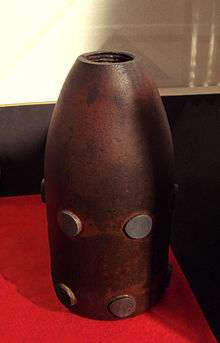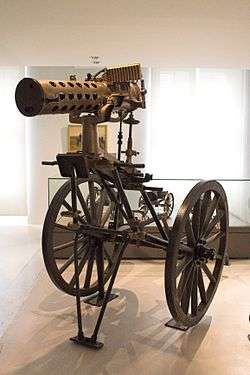La Hitte system


Right image: Shell used in Japan during the Boshin war.
The La Hitte system (French: "Système La Hitte"), named after the French general Ducos, Count de La Hitte,[1] was an artillery system designed in March 1858 to implement rifled muzzle-loading guns in the French Army.
Conception
The La Hitte system was developed through the collaborative work of Lieutenant-colonel Treuille de Beaulieu ("Directeur de l'atelier de précision") who had developed the principle and General de La Hitte ("Président du Comité d'Artillerie") who had implemented it:[2]
"It would be unjust to omit on this occasion the name of General La Hitte, who at once took upon himself the responsibility of the new principles, and has continued with the utmost ability to carry them into execution. It is mainly to his firm adherence to these principles, and to the general uniformity of the system he established, that the success of the new arm is to be attributed"
Specifications


Right image: Hexagonal rifling of Le Pétulant (detail).
The new rifled guns were used from 1859 during the Franco-Austrian War in Italy.[3] These guns were a considerable improvement over the previous smooth-bore guns which had been in use.[3] They were able to shoot at 3,000 meters either regular shells, ball-loaded shells or grapeshot. They appear to have been the first case of usage of rifled cannons on a battlefield.[4]
The system was muzzle-loading, and the shells could only be exploded at two set distances. The shells, based on the 1847 invention of Captain Tamisier, were oval-shaped and had small protrusions to follow the grooves of the bore. Previous guns, such as the Canon obusier de 12, were rifled to accommodate the system.[5] The system included newly rifled siege guns of 12 cm, 16 cm and 24 cm bore, new field guns of 4 cm and 12 cm bore, new siege guns of 12 cm and 24 cm bore, and a mountain gun of 4 cm bore.
Change in meaning of gun designations
Note that with the introduction of rifling and elongated shells replacing the old roundshot, guns could now fire projectiles weighing nearly twice the previous weight possible for a given bore (calibre). The rifling gave a far greater range for a given propellant charge, hence a minimal increase in gunpowder was needed for the heavier shells. While the La Hitte guns retained the traditional 4 designation, the number now approximated to kg rather than the livre (French pound) as previously. Hence the Canon de campagne de 4 La Hitte fired a shell weighing nearly 4 kg. Similarly, the Canon de 12 La Hitte, basically a rifled 12-cm Napoleon, now fired an 11.5 kg shell compared to the Napoleon's 4.1 kg projectile.[6]
Obsolescence
The La Hitte system would be superseded in 1870 with the work of Jean-Baptiste Verchère de Reffye and the development of breech-loading rifled guns.
Image gallery


 Canon de 12 La Hitte, Modele 1859, cast in 1869 at Bourges, bronze. Caliber: 121 mm, rifled. Length: 229 cm. Weight: 878 kg. Ammunition: shells.
Canon de 12 La Hitte, Modele 1859, cast in 1869 at Bourges, bronze. Caliber: 121 mm, rifled. Length: 229 cm. Weight: 878 kg. Ammunition: shells. Canon de 24, L'Aubépine, 1867, Bourges.
Canon de 24, L'Aubépine, 1867, Bourges.
References
| Wikimedia Commons has media related to La Hitte system. |
- ↑ Rifled Field Pieces: A Short Compilation of what is Known of the New Field - Page 32 by Franck Taylor 1862
- 1 2 The Edinburgh Review - Page 499 1864
- 1 2 French Army 1870-71 Franco-Prussian War (1) by Stephen Shann p.37
- ↑ The Long Arm of Lee by Jennings Cropper Wise, Gary W. Gallagher p.30
- ↑ "Napoleon went so far, however, in 1858, as to order his SB guns rifled, under the bastard system known as the "Lahitte System," which continued in general use in France until 1870" in The Long Arm of Lee by Jennings Cropper Wise, Gary W. Gallagher p.30
- ↑ The Edinburgh Review - Pages 500 - 501 Jan - April 1864
